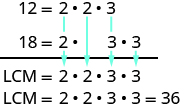| << Chapter < Page | Chapter >> Page > |
Find the prime factorization using the ladder method:
2 ⋅ 2 ⋅ 2 ⋅ 2 ⋅ 5, or 2 4 ⋅ 5
Find the prime factorization using the ladder method:
2 ⋅ 2 ⋅ 3 ⋅ 5, or 2 2 ⋅ 3 ⋅ 5
Find the prime factorization of using the ladder method.
| Divide the number by the smallest prime, 2. |
|
| Continue dividing by 2 until it no longer divides evenly. |
 |
| The quotient, 3, is prime, so the ladder is complete. Write the prime factorization of 48. |
|
Find the prime factorization using the ladder method.
2 ⋅ 3 ⋅ 3 ⋅ 7, or 2 ⋅ 3 2 ⋅ 7
Find the prime factorization using the ladder method.
2 ⋅ 3 ⋅ 7 ⋅ 7, or 2 ⋅ 3 ⋅ 7 2
One of the reasons we look at multiples and primes is to use these techniques to find the least common multiple of two numbers. This will be useful when we add and subtract fractions with different denominators.
A common multiple of two numbers is a number that is a multiple of both numbers. Suppose we want to find common multiples of and We can list the first several multiples of each number. Then we look for multiples that are common to both lists—these are the common multiples.
We see that and appear in both lists. They are common multiples of and We would find more common multiples if we continued the list of multiples for each.
The smallest number that is a multiple of two numbers is called the least common multiple (LCM). So the least LCM of and is
Find the LCM of and by listing multiples.
List the first several multiples of and of Identify the first common multiple.
The smallest number to appear on both lists is so is the least common multiple of and
Notice that is on both lists, too. It is a common multiple, but it is not the least common multiple.
Find the least common multiple (LCM) of the given numbers:
36
Find the least common multiple (LCM) of the given numbers:
72
Another way to find the least common multiple of two numbers is to use their prime factors. We’ll use this method to find the LCM of and
We start by finding the prime factorization of each number.
Then we write each number as a product of primes, matching primes vertically when possible.
Now we bring down the primes in each column. The LCM is the product of these factors.

Notice that the prime factors of and the prime factors of are included in the LCM. By matching up the common primes, each common prime factor is used only once. This ensures that is the least common multiple.

Notification Switch
Would you like to follow the 'Prealgebra' conversation and receive update notifications?